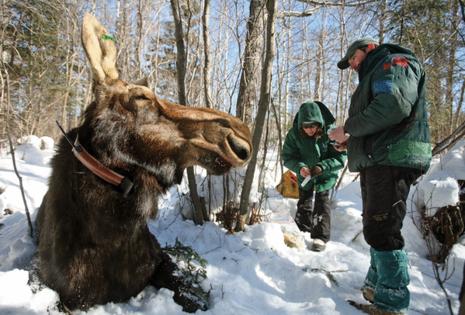Researcher hopes to solve the mystery of the vanishing Minnesota moose
Published in News & Features
As a young wildlife biologist, Adam Mortensen has worked in the mountains of New Mexico, the high desert of northern California and the wilderness of Isle Royale, where he lived out of a tent and backpacked daily to study wolves.
Now he will ride a snowmobile through the forests of far northeastern Minnesota to help solve the mystery of disappearing moose.
Mortensen, a Wisconsin native, will live in Grand Marais for the next five years to help identify how yearling and 2- and 3-year-old moose contribute to restoring Minnesota’s moose population, which is half the size of what it was 20 years ago.
That age group is in need of study, experts say, and it’s hoped that the results will help identify habitat and wildlife management strategies to benefit the twig-eating animals called mooz by the Ojibwe.
“It’s the most fun job ever,” said Michelle Carstensen, wildlife health program supervisor for the Minnesota Department of Natural Resources. “All moose, all the time.”
The job listing, issued by St. Paul-based National Parks of Lake Superior Foundation, drew more than 50 high-caliber applicants from as far away as Alaska, Texas and Florida, Carstensen said.
If you weren’t a hard-core wildlife biologist, you might balk at the job requirements. Among them: navigating icy northwoods roads on short notice, weekends included, to locate a freshly fallen moose.
Mortensen said he wasn’t daunted by the job description, one that will require him to off-road into the vast backcountry surrounding the Boundary Waters on an ATV or snowmobile. Young moose in the study will be wearing tracking collars that also signal when they die. Performing necropsies in the bush is part of the job — all for $65,000 a year.
“It’ll be some white-knuckle driving and I don’t have a ton of snowmobile experience,” Mortensen confessed. “So, yeah, let’s see. I might change my answer.”
He was kidding. Mortensen, 26, said he’s grown accustomed to the comforts of living in Duluth as a masters degree student at the University of Minnesota Duluth, where he’s close to finishing his degree. Grand Marais, 110 miles northeast of Duluth with a permanent population of about 1,300 people, will provide an interesting change of pace, he said.
“It’ll be nice to live in such a beautiful place,” Mortensen said. “I’ll have to get myself a pair of cross-country skis.”
Carstensen said Mortensen’s presence in Minnesota’s primary moose range will strengthen a five-year research project that aims to collar 80 yearling moose — 60 females and 20 males — in each of the first three years, in winter. The field work includes collection of fecal samples to lab-test whether the females are pregnant. Putting tracking collars on moose that are 8 to 9 months old has been proven safe in field work by Seth Moore, director of biology and environment for the Grand Portage Band of Lake Superior Chippewa.
Moore, Carstensen and Morgan Swingen of the 1854 Treaty Authority are collaborating on the $2 million project, funded by state lottery proceeds. It’s the National Parks of Lake Superior group that’s employing Mortensen. The helicopter-aided captures will take place in three broad areas around Ely, Isabella and Grand Marais, including the Gunflint Trail.
“The focus is on young females and pregnancy rates as they age,” Carstensen said. “It’s really about filling an information gap. These young moose haven’t been studied.”
Previous research has shown that wolves and bears prey on baby moose in Minnesota. But biologists are trying to determine whether there’s another common cause of mortality for yearlings and 2-year-olds.
If pregnancy rates vary across the moose range, the study might identify areas where forest management could most benefit reproduction, project managers have said. The study could also identify how best to manage wolves, black bears and deer. Whitetails have been found to spread devastating brainworm infections to moose. Winter tick infestations have also taken a toll.
The research plan calls for the use of a DNR airplane equipped with advanced thermal imaging equipment — strong enough to detect whether a collared moose has given birth to a calf or to twins in May of each year. All females that successfully produce at least one calf will be surveyed by a secondary aerial thermal flight much later in the year to estimate calf survival.
Swingen said the findings will be important because habitat contributes to a moose’s ability to get pregnant.
Moore said another purpose of the study is to lift the profile of moose research. Sharing videos, photos, data and narratives might broaden what is now a meager constituency for the animals, he said. The communications angle was inspired in part by eagle nesting cameras like the DNR’s popular EagleCam.
“We’re going to have a website with all this imagery,” Moore said. “Minnesota has been a leader in moose research for a long time.”
Tom Irvine, executive director of National Parks of Lake Superior Foundation, said his nonprofit will handle the messaging.
“This project is so amazing and so cool we really want to bring it to the public,” Irvine said.
The official announcement of the research project is pending.
_____
©2025 The Minnesota Star Tribune. Visit startribune.com. Distributed by Tribune Content Agency, LLC







Comments